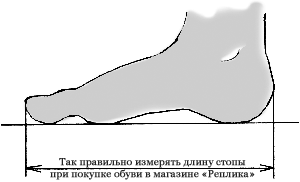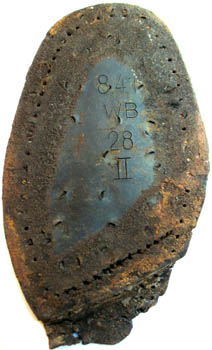Shoe size
To determine the size, you need to measure the foot from the extreme point of the heel to the extreme point of the toe and select the appropriate size in the table.
Find the size
|  |
A bit of history
Europe determines size by the length of the shoe insole. They use the old French system for this and measure the insole using the Paris point. The Paris point is equal to 2/3 cm. Number of Paris points is the size. Shoes with insole length of 42 Paris points (i.e. 28 cm) are size 42. This is Paris point size system.
In the UK, India, South Africa, Australia, the size is determined also by the length of the shoe insole, but they measure not its length but the difference between the length and a given minimum length of the insole. Since the minimum lengths in English-speaking countries are different for men, women and children, the mens size 10 (for example) does not correspond to the female 10. The special point named barleycorn is used for the measurement, it equals 1/3 inch. Size 10 (for example) means that the insole 10 barleycorns longer than minimal one.
In the United States they have different minimum length pads, US men's size number is +1 to English roughly speaking. The US system is called customary.
In Russia the metric system (called Mondopoint) is in use. Size is simply the length of the foot in millimeters. For standardization, a grid with steps of 5 mm or 7.5 mm is used. By the way, this system for army shoes is now used by the NATO.
There are formulas to convert a size from one system to another. But exact results, calculated by the formulas, can include periodic (infinite) decimal fractions. Therefore, the values were rounded and tables made up. Here's one from the site wikipedia.de

Why European size differs from the Russian?
Let me remind you that in Europe the size is tied to the length of the insole, and in Russia - to the length of the foot. Between the length of the insole and the length of the foot should be "margin", so that the foot is placed into the shoes comfortably, not end-to-end. Russian standard GOST 11373-88 (ISO 3355:75) and international ISO/TS 19407: 2015 (GOST R 57425-2017) define the size for the same foot length differently. Therefore, the European size number is larger per unit than the Russian one on average.
How it was during WW2?
The Germans indicated the length of the insole in centimeters on their military shoes, they used a step of ½ centimeter (not the Paris point). They stamped it on the footsteps.
The Russians indicated the maximum length of the foot which will fit into the shoes, in millimeters. Since there was no Mondopoint chart, the Russians used the traditional Paris point, that is, a step of 7-8 mm. Usually it was a convex marking on the rubber sole.
The correspondence of German and Soviet markings during the Second World war is shown in the table below.

One of the layers of a German high-boot.
28 is insole lenght in centimeters.
| Soviet marking | German marking |
| 255 (40) | 27 |
| 262 (41) | 27½ |
| 270 (42) | 28 |
| 277 (43) | 28½ |
| 285 (44) | 29½ |
| 292 (45) | 30 |
| 300 (46) | 30½ |
The width of the foot had 3 degrees for the Soviet military shoes (У — узкий or narrow, С — средний or medium и Ш — широкий or wide), but Germans had 5 grades (designated by numbers 1 through 5, sometimes in Roman).
Should I put the insole in?
Shoes with leather soles are usually cold in winter. Therefore, experienced reenactors recommend to add 3-5 mm insole of polyurethane (foam like a tourist mat). It will be softer and warmer even in summer. If you put an insole, you need to take shoes 1 size larger. Also with thick wool socks: if you plan to wear them, you need to take shoes 1 size larger. But as a rule, the usual thin woolen socks of the Wehrmacht and insoles are enough. It should be understood that leather shoes do not protect the foot from the cold, if the street temperature is below -10° C (10 ° F), for such temperatures you need "valenky" woolen boots, insulated shoes, etc.
Source: en.wikipedia.org, wikipedia.de
© Online shop "Replika".
Copying is allowed only with reference to the source.









